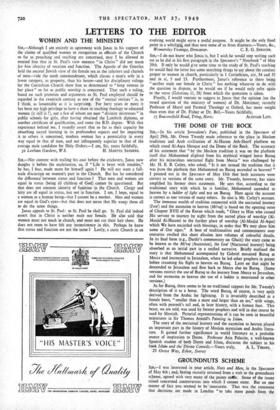THE DOME OF THE ROCK
Sul,—In his article Jerusalem's Fate, published in the Spectator of April 29th, Mr. Owen Tweedy made reference to the place in Moslem traditions and Arab civilisation of Al-Haram Ash-Sharif platform on which stand Al-Aqsa Mosque and the Dome of the Rock. The accuracy of his statement that " by the Moslem tradition it was on the platform itself that Mohammed alighted from his mythical winged horse Buraq after his miraculous nocturnal flight from Mecca " was challenged by Mr. H. E. B. Carley, who asked, " Is it not instead the tradition that it was from the platform that Mohammed on Buraq ascended to heaven? " I pointed out in the Spectator of May 13th that both accounts were correct as versions of the same story. Mr. Tweedy, however, has since amplified his former short statement. He says that, according to the traditional story with which he is familiar, Mohammed ascended to heaven by a ladder of light and not on Buraq. Here again the account is correct as one version of many others. So also is Mr. Catley's account.
The immense wealth of tradition connected with the nocturnal journey (Isra') and the ascension to heaven (Wrap is based on the opening verse of Chapter XVII of the Koran which reads, " Glory to Him who caused His servant to journey by night from the sacred place of worship (Al- Masjid Al-Haram) to the further place of worship (Al-Masjid Al-Aqsa) which We have encircled with blessings, in order that We may show him some of Our signs." A host of traditionalists and commentators over centuries swelled this short allusion into volumes of colourful details. In its final form (e.g., Dardir's commentary on Ghaiti) the story came to be known as the Meraf (Ascension), the Isra' (Nocturnal journey) being absorbed as an initial part in a unified narrative. Briefly outlined the story is that Mohammed accompanied by Gabriel mounted Buraq at Mecca and journeyed to Jerusalem, where he led other prophets in prayer before resuming his flight to heaven on Buraq. Later on that night he descended to Jerusalem and flew back to Mecca also On Buraq. (Some versions restrict the use of Buraq to the journey from Mecca to Jerusalem, and for ascension to heaven the use of a ladder is mentioned in other versions.) As for Buraq, there seems to be no traditional support for Mr. Tweedy's description of it as a horse. The word Buraq, of course, is very aptly derived from the Arabic for lightning. It is invariably described as a female beast, " smaller than a mare and larger than an ass," with wings, often with peacock's tail and, in later history, with a human face. This beast, we are told, was used by former prophets and will in due course be used by Messiah. Pictorial representations of it can be seen in beautiful miniatures in Sir Thomas Arnold's Painting in Islam.
The story of the nocturnal journey and the ascension to heaven played an important part in the history of Moslem mysticism and Arabic litera- ture. It gained further significance in world literature as a probable source of inspiration to Dante. Professor Asin Palacios, a well-known Spanish student of both Dante and Islam, discusses the subject in his
book lslain and the Divine Comedy.—Yours truly, A. L. Maim'. 23 Grove Way, Esher, Surrey






































 Previous page
Previous page